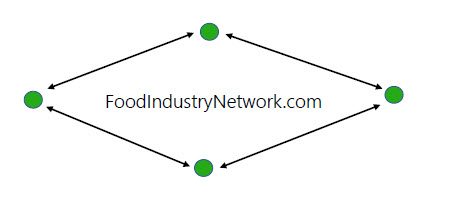- A new study has compared the impact of today’s farm machinery on the soil to that of sauropods, the largest group of dinosaurs to have walked upon the Earth.
- The heavy toll of today’s bulky farm machinery can result in permanent soil compaction underneath the first 7.87 inches or so.
- Too much soil compaction can reduce plant growth, leading to less available food.
- Worldwide, the researchers estimated that 20% of farmland has a high risk of productivity loss due to compression caused by modern farming machinery.
Footprints in the soil aren’t something you might normally associate with having a big impact on the environment, but soils are delicate ecosystems made up of circulating air and water that nourish organisms and plant roots, scientists from Lancaster University reported in The Conversation.
Too much soil compaction can reduce plant growth, leading to less available food. It can also increase the risk of floods as the earth becomes less porous, speeding up runoff and filling up waterways more quickly.
Imagine if giant footprints, like those of the dinosaurs — or tread from machines of dinosaur mass — were relentlessly pounding or pushing away at the earth, tamping it down until much of the air and water were pressed out. A new study compared the impact of today’s farm machinery on the soil to that of sauropods, the same group of dinosaurs featured in Jurassic Park and the largest to have ever walked upon the Earth. The largest of the sauropods were thought to weigh about 66 tons — comparable to a modern, fully-loaded combine harvester, Jess Davies, chair professor in sustainability at Lancaster University, and professor of soil science at Lancaster University John Quinton reported in The Conversation.
“Compaction can happen within a few seconds when we drive on the soil, but it can take decades for that soil to recover,” said professor of soil management at the Swedish University of Agricultural Sciences Thomas Keller, who was the study’s lead author, as BBC News reported.
The study, “Farm vehicles approaching weights of sauropods exceed safe mechanical limits for soil functioning,” was published in the journal Proceedings of the National Academy of Sciences.
When soils are subjected to too much pressure, they can become “chronically compacted,” reported The Conversation, and as farm machinery becomes weightier, that pressure intensifies. Over the last 60 years, farming machinery like tractors has become much bigger, and a combine is nearly ten times heavier now than in the 1960s.
“Soil structure emerges as a central trait for many ecological, hydrological, and agronomical functions, serving as a fragile scaffolding for biological activity,” Keller and co-author Dani Or, who is a full professor of soil and terrestrial environmental physics at ETH Zürich, wrote in the study.
Not only has the weight of farm machines increased, so have the sizes of their enormous tires, The Conversation reported. The width of a tire actually reduces the pressure on the soil’s surface and serves to aid in keeping the vehicle from sinking. Due to this spreading out of pressure, surface-level soil compaction hasn’t changed much with the bulking up of farming vehicles; it’s deeper down where issues arise. As whatever is putting pressure on the soil gets heavier, whether it be an animal or a machine, the more the soil will become compressed deeper down.
“The intensification of modern food production with its reliance on efficient agrotechnical practices presents a growing risk to the maintenance of favorable soil structure and poses a threat to the long-term productivity of arable land. Of particular concern is the steady increase in the weight of modern agricultural vehicles that may have already caused chronic subsoil compaction,” wrote Keller and Or.
In the study, the scientists theorized that damage to the soil ecosystem by the sauropods may have been limited by their sticking to familiar pathways.
The heavy toll of today’s bulky farm machinery can result in permanent soil compaction underneath the first 7.87 inches or so, beneath the level of tilling, which can lead to reduced levels of oxygen in the soil, as well as keeping roots from penetrating deeper, reported The Conversation.
Worldwide, the researchers estimated that 20 percent of farmland has a high risk of productivity loss due to compression caused by modern farming machinery. The amount of soil compaction depends on the vehicle, how it’s used and the amount of moisture and kind of soil. Farms in North America and Europe face the biggest risks due to the prevalence of the biggest farm vehicles being used to till large-scale agricultural operations on soil with high levels of moisture.
“Soil can only withstand so much pressure – whether from compaction or other threats such as continual harvesting, erosion or pollution. Humans must act to reduce pressures on soils, or we risk going the way of the dinosaurs,” Davies and Quinton wrote in The Conversation.
Two billion people in the world currently suffer from malnutrition and according to some estimates, we need 60% more food to feed the global population by 2050. Yet the agricultural sector is ill-equipped to meet this demand: 700 million of its workers currently live in poverty, and it is already responsible for 70% of the world’s water consumption and 30% of global greenhouse gas emissions.
New technologies could help our food systems become more sustainable and efficient, but unfortunately the agricultural sector has fallen behind other sectors in terms of technology adoption.
Launched in 2018, the Forum’s Innovation with a Purpose Platform is a large-scale partnership that facilitates the adoption of new technologies and other innovations to transform the way we produce, distribute and consume our food.
With research, increasing investments in new agriculture technologies and the integration of local and regional initiatives aimed at enhancing food security, the platform is working with over 50 partner institutions and 1,000 leaders around the world to leverage emerging technologies to make our food systems more sustainable, inclusive and efficient.
Learn more about Innovation with a Purpose’s impact and contact us to see how you can get involved.



